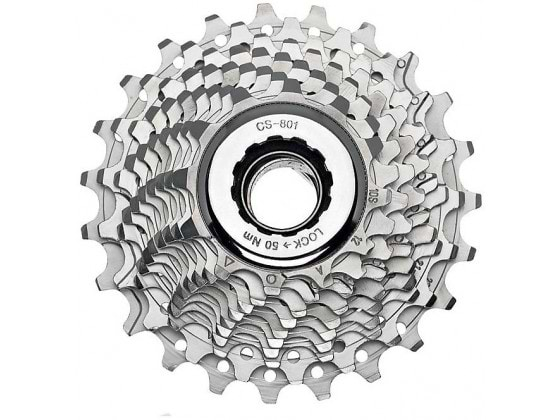Bike Cassette Buying Guide - Ribble Cycles
Cassette Buying Guide
The cassette on your bicycle can be found on the rear wheel and is a cluster of sprockets that are a part of the drivetrain. They slide onto the freehub, the ratchet system that controls the drive of your bicycle when you pedal, and can have anything from 5 to 12 ‘speeds’. The most common however are 9, 10 and 11 speed cassettes.
Cassettes are an important part of your drivetrain, and the one that is on your bicycle can have a big influence on your ride and cadence (the revolutions per minute your legs spin). Whilst riding, and if you put your chain onto one of the larger sprockets (increasing the teeth), your pedalling will become easier, letting you spin your legs faster and hopefully getting you up the steeper hills. For coming down the hill, and to avoid your legs ‘spinning out’, put the chain onto the smaller sprockets, which will allow you to keep pushing power through the drivetrain. The idea is to keep your legs spinning as smoothly and efficiently as possible by using the optimal gear for any given moment.
Choosing a Cassette
Though it can seem a little daunting at first choosing a cassette for your bicycle, once you understand what’s required, it is easy.
The first thing to look at is what style of freehub your wheels are running. Shimano and SRAM freehubs use the same ‘key’ attachment, whilst Campagnolo make use of a different fitment. For this reason, if your freehub is a Campagnolo one, you will only be able to use a Campagnolo compatible cassette. Shimano and SRAM are interchangeable.
Gears and Ratio
Next is how many gears your groupsets uses. This is particularly important as you can only use an 11 speed cassette with an 11 speed groupset and so on. So if you are using a Shimano 11 speed groupset, you can choose cassettes from the 105, Ultegra and Dura Ace ranges if you want to save some weight.
Lastly, you need to choose the ratio. This is displayed by two numbers such as 11-23. What this refers to is the number of teeth on the smallest sprocket, and on the largest. The closer the two numbers are together, the less of a jump there is between gears, resulting in smooth gear changing, perfect for racing. If you know you struggle with the hills this would not be the best, so look for a cassette with a good spread of gears, such as the popular 11-32 cassette.
Anything else to consider?
If looking to completely change the gearing on your bicycle it is worth bearing in mind the chainset also, as different combinations can make your bike easier to ride up hills, or make it more race orientated. For our guide on chainsets, read here; Chainset Buying Guide.
If you are simply putting on a new cassette as your current one has worn out, it should be a straight forward swap, but do consider putting on a new chain also, as they usually wear out at a similar rate as each other. Changing one and not the other can result in skipping gears when you apply pressure through the pedals.
When your changing ratios on your cassette there are a few things to bear in mind. The first is if the derailleur fitted to your bicycle can accommodate a bigger ratio. Shimano recommend a ‘medium cage’ road derailleur for anything above a 28T rear sprocket. You will also likely need to lengthen the chain so that it is not too tight when on the larger sprockets if going larger, or shorten it if going to a smaller ratio.
View All CassettesPosted by

Andy Mc
Andy is the Product Specialist and Content Writer at Ribble. He takes part in all disciplines of cycling, but can mostly be found either on his road bike or on the mountain bike trails.
Customer Care
If you are in any doubt about what is best for you then our Cycling Experts can help via email or telephone
Email: [email protected]
Tel: +44 (0)1772 963400


